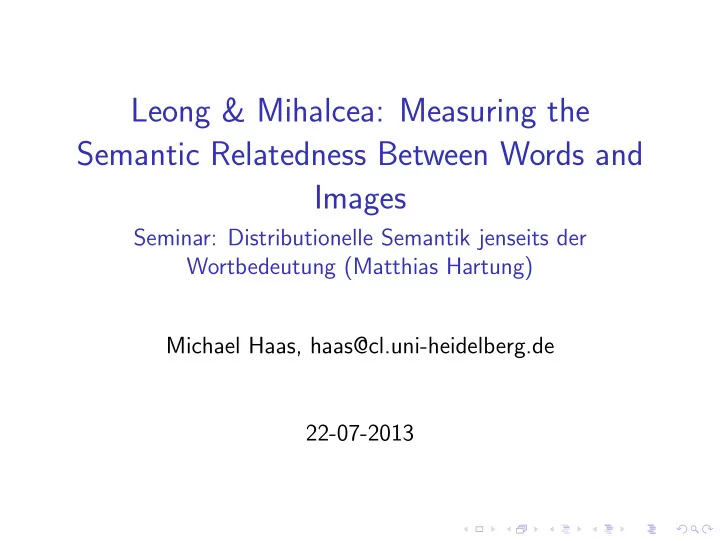

Leong & Mihalcea: Measuring the Semantic Relatedness Between Words and Images Seminar: Distributionelle Semantik jenseits der Wortbedeutung (Matthias Hartung) Michael Haas, haas@cl.uni-heidelberg.de 22-07-2013
Overview ◮ Introduction Multimodal Semantics ◮ Algorithm: Text + Pictures ◮ Results ◮ Questions? Too fast? Ask!
Multimodal Semantics ◮ Distributional Semantics on text corpora: uni-modal ◮ Integrate different modalities: multi-modal ◮ Feature Norms ◮ Pictures ◮ Why: ◮ Obvious things go un-mentioned ◮ Human cognition is situated → Distributional semantics is like ”learning meaning by listening to the radio” 1 1 McClelland, cited according to Johns &Jones, 2011
Algorithm: Text + Pictures ◮ Task: measure semantic relatedness between words and images ◮ Data Set: ImageNet, extension of WordNet ◮ Select 167 synsets ◮ Select nouns from synsets and glosses ◮ Select one image at random from synset ◮ How to compare images and words?
Algorithm: Representation ◮ For text: build term-document matrix ◮ Vector length: 167 documents ◮ For images: represent image as bag of visual words
Algorithm: Bag of visual words ◮ General approach for feature extraction from images ◮ Feature Detection: split image into partitions ◮ Feature Description: represent image as set of vectors ◮ Visual Codeword Generation: cluster vectors
Algorithm: Bag of visual words ◮ Extract 20px square patches at every 10px boundary ◮ Represent using SIFT descriptors: Scale-Invariant Feature Transform ◮ Cluster into 1000 code words → Image is now represented as a bag of visual code words
CMSM for Sentiment Analysis: Eval Results Figure : Bruni et al., 2012
Algorithm: Map images into document space ◮ Represent each code word as vector: distribution over document space → Image is represented as set of vectors ◮ Flatten image represention: sum over all vectors → Image is now represented as a single vector in document space
Algorithm: Compare images and words ◮ Words and images are mapped into document space ◮ Reduce dimensions using LSA ◮ Measure similarity: cosine similarity → Direct comparison of vectors in term-document and codeword-document space
Evaluation ◮ Image-Centered Scenario → Given 12 associated words, rank according to relatedness to image ◮ Arbitrary-Image Scenario → Measure similarity between arbitrary images and words irregardless of synset membership ◮ Gold Standard: extract 12 words from synset, relatedness rated by MTurkers
Evaluation: Baselines ◮ Random baseline ◮ Vector-based baseline w/o LSA ◮ Upper bound: human performance based on annotator data
Evaluation: Results ◮ Image-Centered ◮ Vector-based baseline: 0 . 262 correlation to gold standard ◮ LSA-based: 0 . 339 ◮ Human upper bound: 0 . 687 ◮ Arbitrary-Image ◮ Vector-based: 0 . 291 ◮ LSA-Based: 0 . 353 ◮ Human upper bound: 0 . 764 ◮ Adding more synsets brings correlation values to ∼ 0 . 45
Summary ◮ Comparing images to text: it works! ◮ More data is better data ◮ How can we enrich textual data with image data? → For starters, just concatenate textual vector and pictoral vector (Bruni et al., 2012)
References I Leong, C. W., & Mihalcea, R. (2011, January). Measuring the semantic relatedness between words and images. In Proceedings of the Ninth International Conference on Computational Semantics (pp. 185-194). Association for Computational Linguistics. Bruni, E., Boleda, G., Baroni, M., & Tran, N. K. (2012, July). Distributional semantics in technicolor. In Proceedings of the 50th Annual Meeting of the Association for Computational Linguistics: Long Papers-Volume 1 (pp. 136-145). Association for Computational Linguistics.
Recommend
More recommend